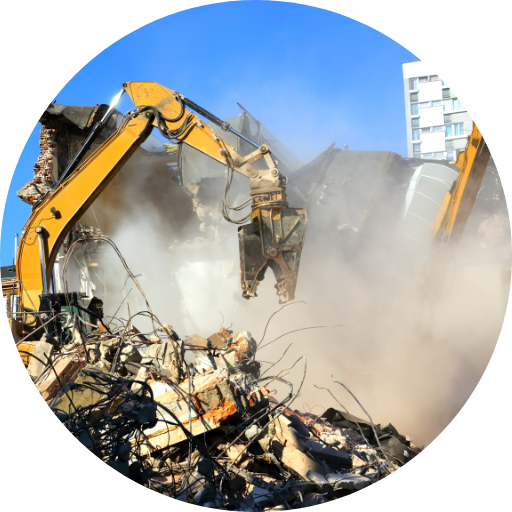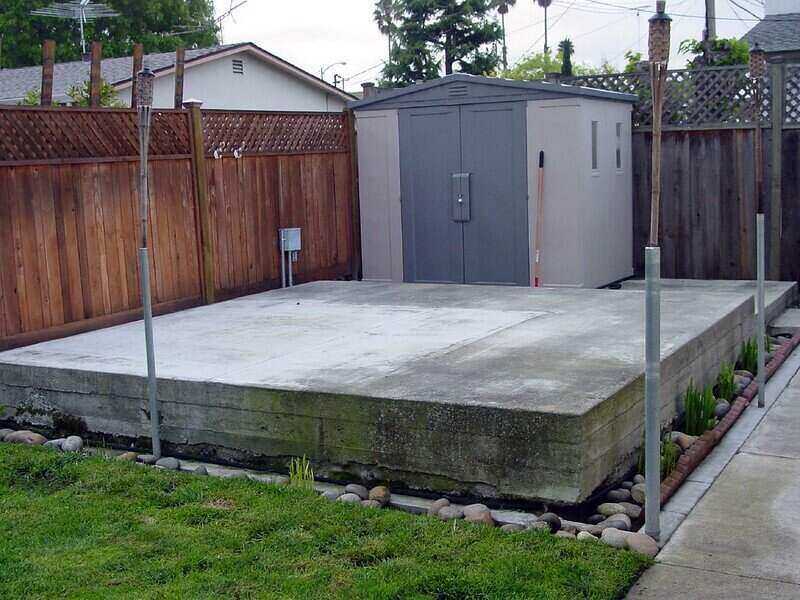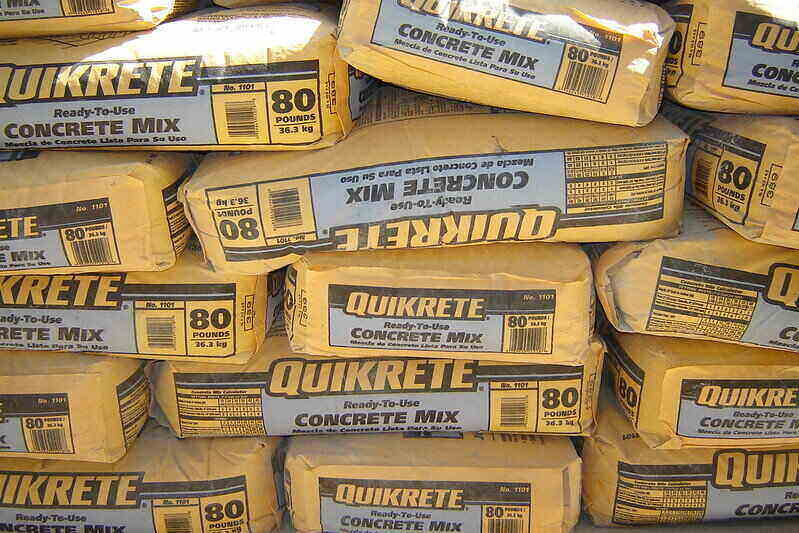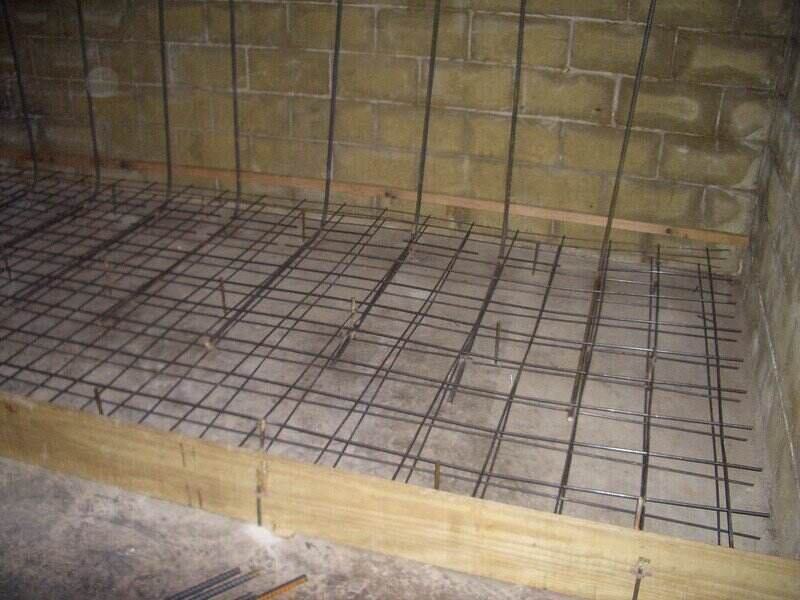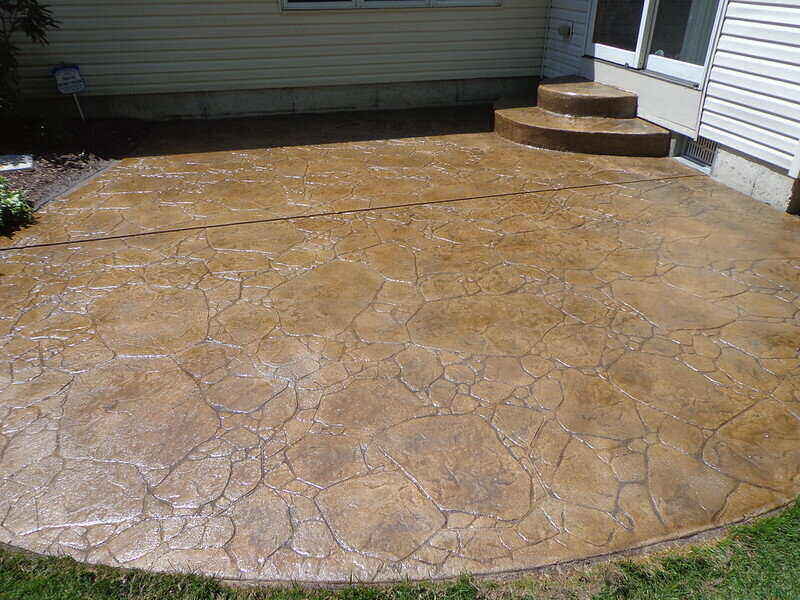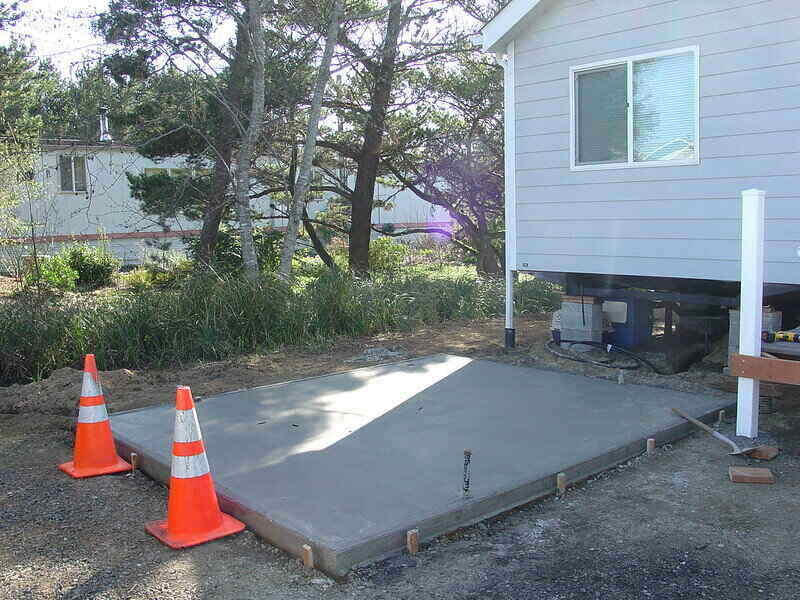Concrete costs an average of $117 per cubic yard, with a typical range between $104 and $144 per cubic yard. Concrete costs per yard will vary depending on how far you live from the delivery company, how much concrete you order, and the type of concrete you need.
Homeowners who order less than a truckload of concrete can expect to pay an additional $43 per cubic yard.
Don’t know how much concrete you need for your DIY project? We’ll help you estimate how many cubic yards to order. Want to skip the DIY route and hire a concrete contractor instead? Our pricing guide has the answers (and the cost estimates).
Table of Contents
How Much Does Concrete Cost Per Yard?
- National Average: $117 per cubic yard
- Typical Range: $104 to $144 per cubic yard
Having ready-mix concrete delivered to your home typically costs an average of $117 per cubic yard or between $104 to $144 per cubic yard.
When you hire a concrete pro to install a concrete slab for you, labor and materials rates are typically charged per square foot rather than per cubic yard. When you order concrete in bulk, that’s when you’ll most likely have to pay per cubic yard.
Keep in mind that the price of concrete will vary depending on the concrete’s strength, how much you order, and the distance the delivery company needs to travel.
Get FREE Quote By Concrete Removal Seattle WA
Cost Estimator by Amount of Concrete
On average, homeowners pay $117 per cubic yard of concrete, with a typical cost range between $104 and $144 per cubic yard. But don’t start calculating your costs just yet –– there’s something you need to know about buying in bulk, and it’s called a short load fee.
Buying by the truckload is typically a total of 10 cubic yards, though this can vary from company to company. If you’re ordering less than a truckload of concrete, you’ll be charged a short load fee for running a concrete truck that’s partially empty.
Read More: How much does a Concrete Slab Cost?
How much is a short load fee? The short load fee will vary depending on the company. On average, a short load fee costs an additional $43 per cubic yard.
If you’re ordering less than a truckload of concrete, expect to pay between $147 and $187 per cubic yard (short load fee included). Otherwise, if you’re ordering a truckload or more, expect to pay the typical range –– $104 to $144 per cubic yard.
Below you’ll find the average price per cubic yard. Keep in mind that a truckload is usually 10 cubic yards of concrete. The short load fee has been applied to cubic yards 1 through 9.
| CUBIC YARDS | AVERAGE COST | TYPICAL COST RANGE |
| 1 | $160 | $147 to $187 |
| 2 | $320 | $294 to $374 |
| 3 | $480 | $441 to $561 |
| 4 | $640 | $588 to $748 |
| 5 | $800 | $735 to $935 |
| 6 | $960 | $882 to $1,122 |
| 7 | $1,120 | $1,029 to $1309 |
| 8 | $1,280 | $1,176 to $1,496 |
| 9 | $1,440 | $1,323 to $1,683 |
| 10 | $1,600 | $1,040 to $1,440 |
| 15 | $1,760 | $1,560 to $2,160 |
| 20 | $1,920 | $2,080 to $2,880 |
| 25 | $2,080 | $2,600 to $3,600 |
| 30 | $2,240 | $3,120 to $4,320 |
How much does one cubic yard cover?
It depends on how thick you want your concrete slab. Concrete slabs are a minimum of 4 inches thick, but some slabs are as thick as 8 inches.
One cubic yard of concrete can cover:
- A 4-inch thick slab with an 81-square-foot area
- A 5-inch thick slab with a 65-square-foot area
- A 6-inch thick slab with a 54-square-foot area
How many cubic yards do you need?
You’re ready to order the concrete for your new slab, but you don’t know how much you need. The first step is to calculate your slab’s total area in cubic feet. Then you’ll convert that measurement to cubic yards.
Here’s how it works:
If you’re pouring a square or rectangular slab:
Step 1: Convert the slab’s thickness in inches to feet. To do this, you divide the slab’s thickness in inches by 12 inches.
For example:
4 inches ÷ 12 inches = 0.33 feet
5 inches ÷ 12 inches = 0.42 feet
6 inches ÷ 12 inches = 0.5 feet
Step 2: Multiply the slab’s width, length, and height to determine the slab’s total cubic feet.
For example, if you want to make a slab that’s 10-feet long, 15-feet wide, and 5-inches thick, then your equation will look like this:
10 feet (length) x 15 feet (width) x 0.42 feet (height) = 63 cubic feet
Step 3: Convert cubic feet into cubic yards. To do this, you must divide the total cubic feet by 27, as there are 27 cubic feet in one cubic yard.
63 cubic feet ÷ 27 cubic feet = 2.33 cubic yards
Conclusion: A concrete slab that’s 10 feet long, 15 feet wide, and 5 inches thick is 2.33 cubic yards of concrete. On average, expect to pay a total bill ranging between $343 and $436 for 2.33 cubic yards of concrete, short load fee included.
If you’re pouring a circular slab:
Step 1: Convert the slab’s thickness in inches to feet. To do this, you’ll need to divide the slab’s thickness in inches by 12 inches.
For example:
4 inches ÷ 12 inches = 0.33 feet
5 inches ÷ 12 inches = 0.42 feet
6 inches ÷ 12 inches = 0.5 feet
Step 2: Determine the total volume in cubic feet, which equals π (3.14) times the slab’s radius squared times the slab’s height (thickness). Remember, the radius is the distance from the circle’s center to its circumference or half the diameter.
For example, if you want a circular slab with a 10-foot diameter and a 6-inch thickness, the equation will look like this:
3.14 (π) x 52 feet (radius) x 0.5 feet (height) = 39.25 cubic feet
Or
3.14 (π) x 5 feet (radius) x 5 feet (radius) x 0.5 feet (height) = 39.25 cubic feet
Step 3: Convert the volume in cubic feet to cubic yards. To do this, you’ll divide the total volume in cubic feet by 27 because there are 27 cubic feet in a cubic yard.
39.25 (total volume in cubic feet) ÷ 27 cubic feet = 1.45 cubic yards
Conclusion: A concrete slab in the shape of a circle with a 10-foot diameter and 6-inch thickness will contain 1.45 cubic yards of concrete. Most homeowners can expect to pay between $213 and $271 for 1.45 cubic yards of concrete, short load fee included.
Other Factors That Affect Cost
Most homeowners can expect to pay between $104 to $144 per cubic yard when buying a truckload (or more) of concrete. But how can you estimate where your concrete order will fall within that range? And if you live far away from the concrete mixing company or need delivery on the weekend, you might see an additional cost on your final bill.
- Type of Concrete: The stronger your concrete, the higher your bill.
- Delivery Distance: If your home is far away from the site, you’ll have to pay for the distance.
- Delivery Day: Need concrete delivered over the weekend? Expect to pay a fee.
- Pre-Mixed Concrete Bags: Pre-mixed concrete bags are an alternative to buying concrete in bulk, but it’s not always the best money saver.
Type of concrete
Not all concrete mixes cost the same. The most significant price factor between concrete mixtures is strength or PSI (pounds per square inch). The higher your concrete’s PSI, the stronger and more expensive it will be per cubic yard.
You’ll want to reserve a high PSI for a concrete slab that’s going to bear a lot of weight, such as a driveway or foundation.
Patios and walkways don’t typically need to withstand heavy objects, which is why their concrete usually costs less per cubic yard than concrete for a weight-bearing surface.
| PSI | AVERAGE COST * per cubic yard |
AVERAGE COST * per cubic yard, plus short load fee |
| 3,000 | $100 to $115 | $143 to $158 |
| 3,500 | $110 to $123 | $153 to $166 |
| 4,000 | $118 to $130 | $161 to $173 |
| 4,500 | $128 to $138 | $171 to $181 |
| 5,000 | $135 to $150 | $178 to $193 |
Delivery distance
Some concrete delivery companies might charge you per mile over a set radius. In other words, the company might not charge delivery fees for orders within a 20-mile radius, but if they need to travel any further than 20 miles, they’ll charge an additional fee per mile.
On average, homeowners can expect to pay $9.75 per mile over the set radius. If the concrete company doesn’t charge fees within 15 miles of their mixing site and you live 35 miles away, you’ll likely be charged around $195 to make up the distance.
Delivery day
If you need your concrete delivered on the weekend, expect an additional fee. You can avoid this by ordering during the workweek.
Pre-mixed concrete bags
When you’re pouring concrete on your own, you don’t always have to obtain your concrete through a delivery company. Another option is to buy pre-mixed concrete bags from a local home improvement store and create the wet concrete yourself at home.
| PRE-MIXED BAGS | AVERAGE COST PER BAG |
| Fast Setting (50 lb.) | $5.29 |
| Mortar Mix (60 lb.) | $6.04 |
| High Early Strength Cement (80 lb.) | $6.65 |
| Portland Cement I and II (93 lb.) | $13.75 |
| Masonry Cement (70 lb.) | $11.50 |
How many concrete bags cover 1 cubic yard?
You might think a pre-mixed bag can make a lot of concrete, but you need to buy a whole lot of them to make up 1 cubic yard of concrete. Concrete mix is often sold in 40-lb, 60-lb, and 80-lb bags that usually make less than 1 cubic foot of concrete.
Let’s figure out how many concrete bags you’ll need and how much you can expect to pay. You might find your concrete project costs less when you buy in bulk from a concrete company than buying by the bag.
| BAG SIZE | TOTAL CUBIC FEET * on average |
| 40 lbs | 0.3 cubic feet |
| 60 lbs | 0.45 cubic feet |
| 80 lbs | 0.6 cubic feet |
Remember, there are 27 cubic feet in 1 cubic yard. You’ll need to find out how many bags make up 27 cubic feet. To do that, divide 27 by the bag’s total volume in cubic feet. The result is how many bags you’ll need to make up 1 cubic yard.
For example, a 60-lb pre-mixed concrete bag typically makes 0.45 cubic feet of concrete. If you’re shopping for 60-lbs bags, divide 27 cubic feet by 0.45 cubic feet. The result is 60 bags of concrete.
27 cubic feet ÷ 0.45 cubic feet = 60 bags
How many bags do I need for my concrete slab?
Step 1: Calculate how many cubic yards of concrete you need. You’ll use the same equation we used at the beginning of this pricing guide for circle and square concrete slabs.
Step 2: Convert the cubic yards into cubic feet. To do this, multiply the total cubic yards by 27 because there are 27 cubic feet in one yard.
For example, if your slab will contain 0.75 cubic yards, multiply 0.75 by 27.
0.75 cubic yards x 27 cubic feet = Total 20.25 cubic feet
Step 3: Divide the total cubic feet by the concrete bag’s total cubic feet. The result is how many bags you need.
For example, if you’re shopping for 80-lb bags, they’ll likely contain 0.6 cubic feet each –– divide 20.25 (the slab’s total cubic feet) by the bag’s 0.6 cubic feet.
20.25 (total cubic feet) ÷ 0.6 (total cubic feet per bag) = 33.75 (total 80-lb bags)
Cost: On average, an 80-lb bag of High Early Strength Cement costs $6.65. You’ll need to buy 34 bags to make 0.75 cubic yards of concrete, costing you about $226. Having 0.75 cubic yards of concrete delivered to your home is usually much cheaper, costing about $120 (short load fee included).
Basic concrete bag measurements
| BAG SIZE | TOTAL CUBIC FEET * on average |
TOTAL CUBIC YARDS * on average |
TOTAL BAGS TO COVER ONE CUBIC YARD |
| 40 lbs | 0.3 cubic feet | .011 | 90 |
| 60 lbs | 0.45 cubic feet | .017 | 60 |
| 80 lbs | 0.6 cubic feet | .022 | 45 |
Extra Services
Pouring concrete yourself might save on labor costs, but it doesn’t save you time and energy. Sometimes hiring a concrete contractor to install the concrete slab for you is the way to go.
Once your concrete is poured –– either by you or a professional –– it might look a little bare in the landscape. Maybe add curving walkways or attractive retaining walls. We’ll review the cost of landscaping down below.
- Concrete Installation: Concrete slabs, reinforced concrete, stamped concrete –– a pro can handle it all.
- Concrete Removal: Need to remove an existing concrete slab from the job site? Get that checkbook or credit card ready.
- Landscaping: Instagram-perfect landscape features can help spotlight or complement your new stamped concrete patio.
Concrete installation
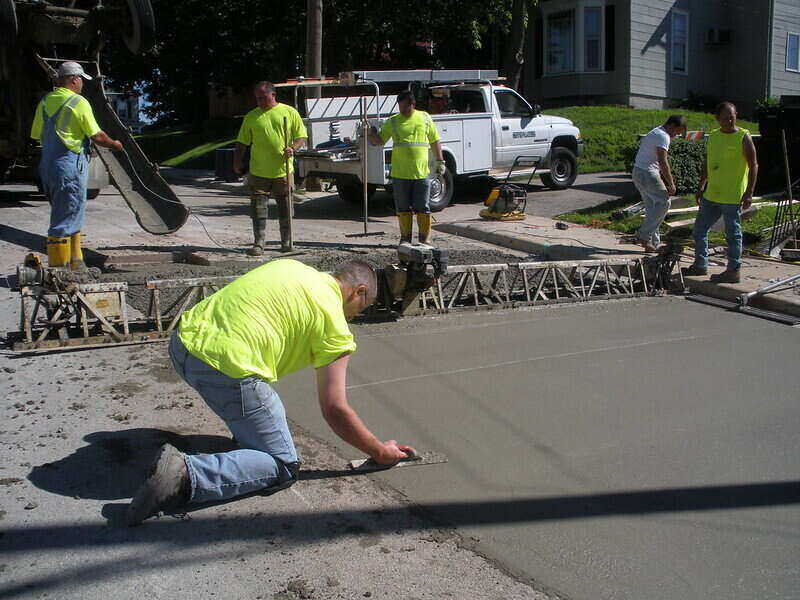
Hiring a professional concrete installer to pour and spread concrete can lead to results you might not have been able to achieve on your own. Handling a DIY concrete project can be challenging, especially when you’re up against the clock. If you decide to opt for professional concrete installation, here’s what you can expect to pay:
Basic concrete slab
A plain concrete slab costs an average of $6.60 per square foot or between $4.34 and $7.73 per square foot. That comes to an average of $660 for a 100-square-foot concrete slab. A basic slab contains no reinforcements, colors, or patterns.
Reinforced concrete
Reinforcing a concrete slab with increased thickness, wire mesh or rebar, or a vapor barrier can improve your concrete slab’s strength and durability.
Keep in mind that reinforced concrete installation costs more than a plain concrete slab, averaging between $9.29 and $10.04 per square foot.
Concrete surfaces
Concrete can be useful for many surfaces, including patios, driveways, foundations –– even countertops. Different concrete surfaces have different rates per square foot, mainly due to the difference in thickness, reinforcements, and required PSI.
| CONCRETE SURFACE | AVERAGE COST * per square foot |
| Concrete Patio | $4.40 to $16 per square foot |
| Monolithic Concrete Foundation | $4.50 to $14 per square foot |
| Concrete Driveway | $6 to $14 per square foot |
Stamped concrete
Stamped concrete can be designed to look like other paver materials, such as natural stone, wood, or brick. Stamping concrete is more expensive than pouring a plain concrete slab, but it’s much more affordable than the luxury pavers it can mimic.
Most homeowners will pay between $9 and $16.25 per square foot for professional stamped concrete or as much as $25.25 per square foot for an advanced design, color additives, and concrete finishes.
Concrete removal
Want to spread your concrete mix where an old concrete slab already exists? You’ll need to remove the old concrete first before you do any pouring. On average, professional concrete removal costs between $2 and $6 per square foot.
Landscaping
You’ve invested hundreds of dollars in your concrete slab; the last thing you want is an unattractive landscape to detract from it. Turn your neighbors’ heads with a fresh green lawn, sweet-smelling flower beds, and attractive, supportive retaining walls.
Homeowners typically spend between $4,000 and $20,317 for landscaping, but total costs will vary depending on the project at hand.
| LANDSCAPING PROJECT | AVERAGE COST |
| Sod Installation | $0.87 to $1.76 per square foot |
| Pathway Installation | $8 to $22 per square foot |
| Tree and Bush Planting | $25 to $3,000 |
| Mulch Installation | $37 to $113 per cubic yard |
| Flower Bed Planting | $650 to $3,000 |
| Retaining Wall Installation | $4,025 to $8,711 |
| Gazebo Installation | $5,364 to $9,027 |
Cost of Concrete Across the U.S.
The costs listed in this pricing guide are all national averages. On a local scale, the cost of concrete might vary depending on supply and demand in your region.
DIY Concrete Installation
If you woke up to a morning to-do list taped to the fridge that reads “Pour a 10 x 20 concrete patio in the backyard,” you’ve got good reason to say, “Honey, I can’t.”
Concrete installation isn’t an ideal project for the average DIYer, as it’s easy to make costly mistakes with concrete. When pouring concrete, you have to get the timing just right; otherwise, you waste an expensive truckload of material. You might be better off hiring a professional concrete contractor.
Take on a DIY concrete project only if you have experience working with concrete. When pouring concrete yourself, here’s what you can expect:
- Clear the land where you plan to pour the concrete. Remove grass, bushes, rocks, and debris until the soil underneath is exposed.
- Tamp the soil. The soil is the concrete’s subgrade, and it must be compact to support the concrete. Otherwise, a shifting subgrade will compromise the concrete’s strength.
- Apply the subbase above the soil subgrade (gravel is a common subbase material). Tamp down the subbase before moving on to the next step.
- Install a wooden perimeter around the subbase. The wooden frame should outline the slab’s shape and help hold in the concrete as you pour and spread it.
- Install the wire mesh or rebar.
- Mix your concrete using a concrete mixer or a wheelbarrow and shovel. Remember to wear a mask, rubber gloves and boots, safety glasses, pants, and a long sleeve shirt.
- Pour the concrete inside the wooden frame. Spread the mixture around with shovels and rakes until the concrete levels out.
- Level and smooth out the wet concrete with a screeding tool.
- Run a bull float across the concrete’s surface. A bull float presses down floating aggregate and allows aggregate-free concrete, known as cream, to rise.
- Edge the sides of the concrete with a concrete edger. Edging helps define the edges and makes them less susceptible to cracking.
- Make joints every 5 to 6 feet with a groover to limit cracks in the concrete.
- Sweep the slab’s surface with a broom. The textured broom bristles help create traction on the concrete, so the surface isn’t too slippery.
- Apply a concrete sealer to help the concrete cure.
Sometimes reading about concrete installation isn’t as helpful as watching it. Check out this instructional video by MARSHALLTOWN for a better understanding of pouring concrete:
FAQ About Pre-Mixed Concrete
1. How much does a truckload of concrete cost?
A truckload of concrete typically contains 10 cubic yards of concrete, though this measurement can vary from company to company. On average, a truckload holding 10 cubic yards costs $1,600.
2. How do you order concrete?
Call your local ready-mixed concrete supplier to inquire about delivery services. If you don’t know how much you should order, they should be able to help you calculate the cubic yards as long as you have your project’s dimensions.
The supplier should also help you estimate the best PSI level for your project. Remember to order 5% to 10% more than you need to account for any wasted concrete mix.
3. How much does it cost to rent a concrete mixer?
Based on rental prices at Lowe’s and Home Depot, renting a concrete mixer costs an average of $75 per day and $301 per week.
Conclusion
When you’re pouring a large slab of concrete, sometimes skipping the bags and buying in bulk can save you a lot of money. And don’t let calculating cubic yards scare you –– it’s easy to determine how many cubic yards you’re going to need as long as you know the dimensions of your concrete slab.
Your concrete patio will be great for hosting cookouts, but who wants to party outdoors where you can’t even get a nice picture standing in the yard? Call up a local landscaping professional near you to give your yard a complete makeover.
The average cost of concrete is $117 per cubic yard, with a typical range between $104 and $144 per cubic yard. When you order less than a truckload of concrete, you’ll be charged a short load fee that averages around $43 per cubic yard.
